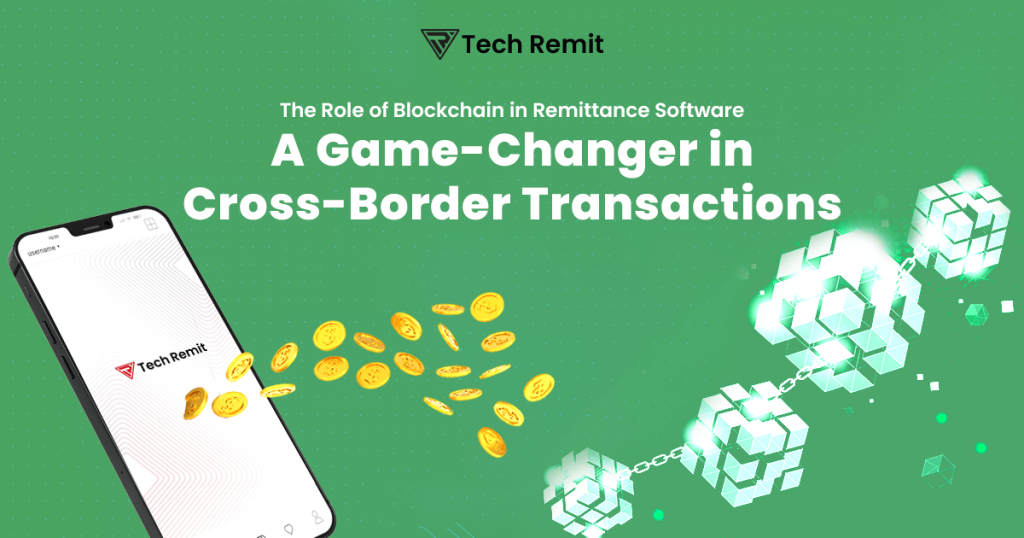The Role of Blockchain in Remittance Software: A Game-Changer in Cross-Border Transactions

Cross-border is a term used for payments between diverse countries. These cross-border payments have great significance in the daily lives of individuals, businesses, merchants, various industries, and international development organizations. Blockchain technology has a role to play in pushing up the global economy, especially in cross-border payments. Blockchain technology is one of its kind in cross-border money transfer. It speeds up the payment by using encryption technology. There are currently a number of blockchain payment platforms operating, and others are due to emerge in the future.
This article will look into the existing cross-border payment system as well as the speedy nature of blockchain. Also, we will assess the main expected alterations in industries and the future of using blockchain for cross-border payments Solutions .
How do regular cross-border payments work?
The transaction cost is normally lower for a remittance transfer than for banking services. In traditional cross-border payments, the ledger is not the same between the sender and receiver. In essence, even the whole agreement should include a security concern too. One of the channels of payment, or payment remittance, is SWIFT. It uses coded messages to direct the transactions. Before one can receive an international payment, he or she needs to register with a payment service provider. This acts as a doorway to payment.
A failure in traceability has always been associated with traditional systems in most cases. It can be a lengthy and expensive process because of the presence of intermediary banks in between. This also includes the trade differences among countries, which make this process even more complex.
Why opt for a Blockchain Network for Transactions?
Blockchain ensures no compromises on immutability. This is unlike a typical case where a centralized authority is replaced with a decentralized network. Thus, in this situation, a chain of nodes confirms the money order. This makes a simple P2P payment as complex as a regular cross-border payment, and it requires you to go through almost as many detours as in the bank branches. The transaction ends within the few negotiators here as it goes on in the blockchain network itself, instantly. There are countless global public blockchains that are able to move money around the world. The transaction may take up to three to five days, but sometimes it has errors that, in some cases, do not reach the destination. However, blockchain supports traceability and transparency. The network helps solve numerous pain points experienced in multiple industries. Simply put, all the transactions are processed instantly with minimal charges.
PaymentsIndustries thriving on Cross-Border
Several cases prove that blockchain-based cross-border payments are easier and quicker. In most B2B industries, banks are responsible for handling cross-border payments. It is possible for the transaction to involve an individual, a bank, or an industry at large. They represent official development assistance (ODA) applications in international remittances.
However, some of the bigger sectors benefiting from blockchain-facilitated inter-country payouts include food and drink, hotels and catering, accounting services, e-commerce, energy, airline transport, equities trading, crowdfunding, etc.
However, it should be noted that blockchain will not just enhance overseas money transfers but even contribute to the general well-being of any business through the preservation and assurance of supply chain management, logistics, etc.
Advantages of Blockchain-Operated Cross-Border Payments
The advent of e-business resulted in more cross-border payments. A few of the advantages related to using blockchain for cross-border payments are:
Faster settlement
Cross-border payments using blockchains are done within seconds or minutes. unlike the normal payment that takes three to five business days. For example, in spite of the fact that the transaction time may be slightly affected by various issues, including the time zones and the currency values, such factors are not very significant since the currency is widely used worldwide. The average time ranges from almost two and a half hours up to around six minutes. It makes the office workload unnecessary, which in turn happens online.
Cost-Effective
Therefore, the transaction will have to be mediated by a group of intermediate banks. Likewise, the banks do not have any relationship with another bank in a foreign land. The third party in the middle earns their commission, and this amount is split between the creditor and the receiver. This fee is, however, charged to the vendor operating the network of a blockchain that is used for performing cross-border payments.
Enhanced Security
A blockchain network has a private key for each of its members. The main act is similar to a digital signature, and if someone wanted to crack this system, he or she had some reason to do this. However, it will render the signature itself invalid. It is called blockchain, synchronously.
Improved Transparency
Traditional reporting firms in the financial sector will no longer exist in the future. Like in blockchain technology, every transaction and holding is visible to an explorer. For even a private, permissionless blockchain, the parties involved have the ability to see the transactions. This verifies the entries in the system. They can achieve this by sharing the information across the platforms and reducing data disparities.
The Bottom Line
Many problems in today’s payment system have led to the integration of blockchain technology into cross-border payments. Blockchain technology will redesign the landscape for cross-border payments. This might act as a technological leap and slowly diminish the current payment models. Tech Remit is the number-one blockchain infrastructure platform for remittance software. The platform we use is multi-protocol; it allows advanced node analysis, node monitoring, network monitoring, and advanced analytics.
Also Read : Top Blockchain Development Companies of 2024